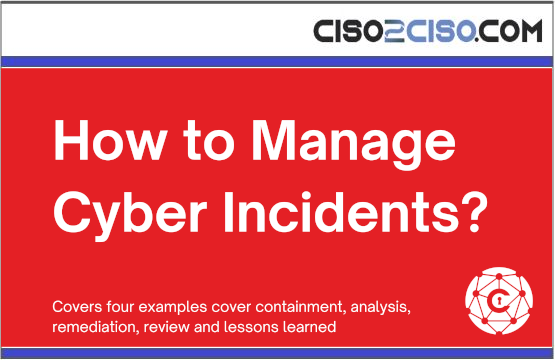Covers four examples cover containment, analysis, remediation, review and lessons learned
The document “Examples on Managing Cyber Incidents” from Cyphere outlines several key strategies and real-world examples for handling cyber threats. It focuses on a structured incident response (IR) process, involving containment, analysis, remediation, and review. Here’s a detailed summary:
Introduction
The guide emphasizes the importance of a well-prepared incident response plan (IRP) for all businesses, regardless of size. It highlights four critical phases of the IR process: containment, analysis, remediation, and review, which are crucial for effectively responding to incidents like phishing, ransomware, and targeted attacks.
Incident 1: Attempted Fraud (Business Email Compromise)
This scenario involves a suspicious email requesting £500,000. Upon detection, containment measures were quickly enacted, including the reset of the CFO’s credentials and a freeze on large payments. The analysis phase traced the email to a compromised account, revealing unusual remote logins from suspicious IP addresses. Remediation involved enforcing Multi-Factor Authentication (MFA) across the organization and working with legal teams for breach assessment. The incident review linked the attack to a phishing campaign from a trusted partner, prompting improvements in phishing simulations, login monitoring, and security processes with external partners.
Incident 2: Malicious Code
In this case, malicious code was detected on a retail website, leading to customer reports of credit card fraud. Containment was swift, with the website taken offline immediately. The analysis uncovered card detail exfiltration and a comprehensive scan identified the compromised areas. The site was restored within 72 hours, and remediation involved implementing stronger scanning, penetration testing, and monitoring processes. The root cause was traced to an outdated plugin. Post-incident, the company enforced secure coding practices and mandated third-party security assessments.
Incident 3: Ransomware Attack
This incident involved ransomware affecting multiple users. Containment was initiated by shutting down infected machines and critical servers. During analysis, compromised admin accounts were identified as the source of the spread. The remediation process included restoring file servers from backups and scanning the network for remaining threats. The post-incident review highlighted the importance of enhanced monitoring for privileged accounts, improved password policies, and regular tabletop exercises to test response readiness.
Incident 4: Targeted Attack
This example involves a targeted attack aimed at stealing client data. Containment included isolating high-risk machines and blocking malicious traffic. Analysis revealed multiple malware variants and pinpointed the attack source to a compromised partner company. Remediation included resetting accounts, blocking unauthorized access, and completing network-wide remediation within five days. The review emphasized enhancing security protocols with third-party partners, improving log retention, and conducting threat-hunting exercises.
Conclusion
Throughout all these scenarios, the document stresses the value of having an IRP that effectively coordinates people, processes, and technology to mitigate damage and recover from incidents. Lessons learned from each incident contributed to refining security practices, from phishing detection to handling ransomware and targeted attacks. This document encourages businesses to regularly test their IR plans, ensuring preparedness for future incidents.
The key takeaway is the critical role of an effective IRP in managing cyber incidents, reducing impact, and enhancing long-term security practices.
Views: 7




















































